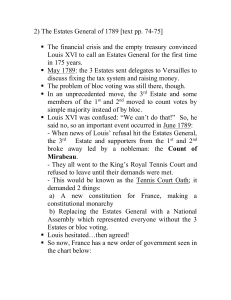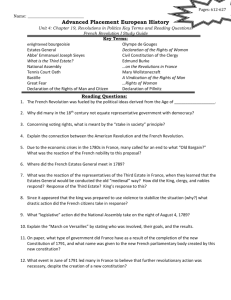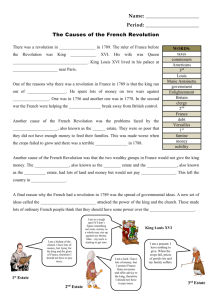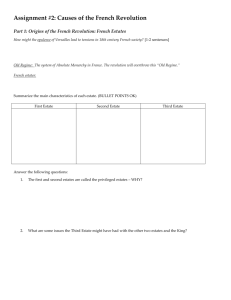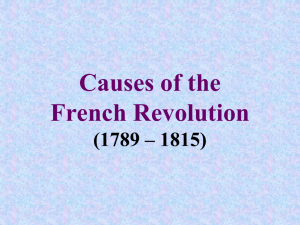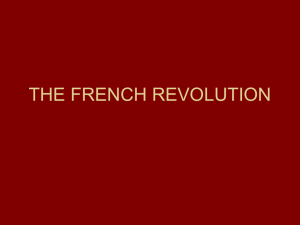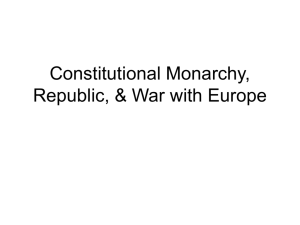French Financial Crisis • American Revolution
advertisement
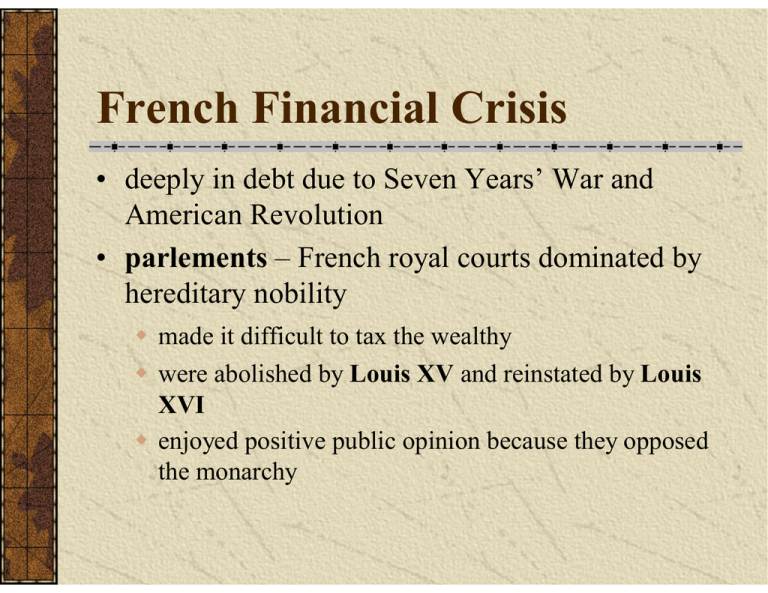
French Financial Crisis • deeply in debt due to Seven Years’ War and American Revolution • parlements – French royal courts dominated by hereditary nobility w made it difficult to tax the wealthy w were abolished by Louis XV and reinstated by Louis XVI w enjoyed positive public opinion because they opposed the monarchy Jacques Necker • royal director-general of finances • argued that the economy was really not that bad • revealed a large portion of royal costs went to pensions for aristocrats • angered the aristocrats and as a result left office Calonne’s Reform Plan • Calonne was minister of finance • wanted to introduce a new land tax that all landowners regardless of class would have to pay • new local assemblies made up of landowners based on land more than social status would determine any additional taxes Assembly of Nobles • aristocracy refused to accept Calonne’s plan • called for the reappointment of Necker • claimed only the Estates General, a medieval institution not used since 1614, could consent to new taxes Deadlock and the Estates General • Calonne replaced by Brienne • Brienne appealed to the Assembly of the Clergy to pay debts, but was refused • parlements wanted privileges of the early 17th century returned to them • Brienne resigns and replaced by Necker – reforms on the horizon The Three Estates • three groups or estates existed in France w First Estate – clergy w Second Estate – nobility w Third Estate – everyone else including middle class • Third Estate warned it would not let the first two estates rule the future of the nation Debate over Estate Voting • Assembly of Notables demanded each estate have an equal amount of representatives • Parlement of Paris believed that each estate should have just one vote each w the First and Second Estates would automatically outvote the Third 2-1 w Third Estate immediately bemoans the arrogance of the aristocracy and now distrusts it. Third Estate Victory • December 1788 – royal council announced Third Estate would elect twice as many representatives to the Estates General as either of the other two Estates • liberal nobles and clergy supported this move • method of voting had not been decided when the Estates General gathered at Versailles in May, 1789 The Cahiers de Doleances • cahiers de doleances – list of grievances registered by local electors to be presented to the king • the grievances were not all that different from the Third Estate w w w w government waste indirect taxes church taxes corruption • the cahiers wanted w more equitable taxes w measures to facilitate trade and commerce The National Assembly • combination of the Third and Second Estate, along with some liberal nobles • officially declared on June 17, 1789 The Tennis Court Oath • the National Assembly gathers in an indoor tennis court to draft a new constitution • King Louis XVI – capitulates and orders the First and Second Estates to meet with the General Assembly • the National Assembly renames itself the National Constituent Assembly and is composed of members of all three estates who shared goals of administrative, constitutional and economic reform of the country Overthrow of the Bastille • winter and spring 1788-1789 – high bread prices cause shortages • July 11, 1789 – Louis XVI – dismisses finance minister Necker • July 14, 1789 – large crowds against Louis XVI go the Bastille– a fortress that once held political prisoners – looking to arm the militia (98 Parisians, several troops and the governor of the Bastille are killed • July 15, 1789 – the National Guard, led by Marquis de Lafayette, officially take over the Bastille. Louis XIV days later recognizes the new government The “Great Fear” • peasant disturbances intensify in the countryside as the aristocrats land is taken over • August 4, 1789 – Several nobles and clergymen renounce their nobility rights at the National Constituent Assembly to quell the riots • “Old Regime” is officially abolished The Declaration of the Rights of Man and Citizen • new constitution drafted on August 27, 1789 • very similar to the Declaration of Independence in proclaiming liberty, freedom, and natural rights • two most powerful ideas were civic equality and popular sovereignty • women not included The Women’s March on Versailles • women upset about bread prices gather at Versailles – October 5, 1789 • King Louis XVI forced to go back to Paris The Political Reconstruction of France • Constitution of 1791 - Legislative Assembly becomes main law making body of France / monarch has limited powers • only active citizens – those paying annual taxes could vote • Olympe de Gouges – she composes Declaration of Rights of Women, using the men’s declaration it calls for women to be treated as citizens • provinces and parlements replaced by departments – equally sized administrative units The Economic Reconstruction of France • workers organizations forbidden by the Chapelier Law • land belonging to the Roman Catholic Church is confiscated and sold creating w further inflation w religious schism w civil war • the assignats – government bonds from the sale of church property – used as currency, but used so often their value went down raising inflation The Civil Constitution of the Clergy (July, 1790) • transformed the Roman Catholic Church into a secular state • embittered relations between the church and the state • Pope Pius VI condemns the both the Civil Constitution of the Clergy and the Declaration of the Rights of Man and Citizen Counterrevolutionary Activity • emigres – aristocrats who left France for bordering countries • King Louis XVI attempts to flee France, but is caught • Declaration of Pillnitz – Emperor Leopold II of Austria and King Frederick William II of Prussia announce that if another European power joins them they will intervene in France to protect the monarchy The Jacobins • club of politically like-minded people from the Third Estate who wanted a republic rather than a monarchy • Girondists – part of the Jacobins that assumed leadership of the Assembly w declared war on Austria w forced Louis XVI and Marie Antoinette into imprisonment The Convention and the Sans-Culottes • The September Massacres – 1,200 people murdered in prisons by Parisans • Convention – September 21, 1792 – Legislative Assembly calls for universal male suffrage and for France to be a monarchy • sans-culottes w name comes from the long trousers of the working people w led a Revolution more radical than the Girondists w anti-monarchical, republican, and wanted the people to make the decisions • policies of the Jacobins – began to cooperate with sansculottes despite not having a problem with wealthy • execution of Louis XVI – beheaded on January 21, 1793 France at War with Europe • Girondists at war with Great Britain, Holland, and Belgium Edmund Burke • wrote Reflections on the Revolution in France (1790) – said revolution will end in military despotism • American Revolution hero Thomas Paine disagreed with him • Other European nations agreed with Burke when France declared war on Austria William Pitt • Britain’s prime minister during Revolution • approved for acts suspending habeas corpus • certain ideas considered treasonable The Reign of Terror • there was a sense that the achievements of the revolution were in trouble by the wars • real and imagined enemies of revolution arrested and executed (peasants, nobles, clergy, business people and exrevolutionary leaders) The Republic Defended. • The Committee of Public Safety – carried out the duties of the executive branch in dictatorial fashion • The levee en masse – led by Lazare Carnot, had military requisition on the entire population w agreed to ceiling on prices in accordance to the sansculotte w carried out more executions Maxim lien de Robespierre • dominant figure of the National Assembly • had support of sans-culotte • called for an assault on all enemies of the Revolution Repression of Republican Women • all women’s societies banned • barred from Convention • Olympe de Gouges executed De-Christianization • new calendar adopted • churches destroyed • some clergy executed Revolutionary Tribunals • executions w Marie Antoinette and royal family w Girondist politicians w peasants opposed to the Revolution w members of sans-culottes • executions carried out by guillotine, shootings and drownings The End of the Terror • Robespierre turns on leaders both from the political left and right • Law of 22 Prairial – tribunal could convict suspects without evidence against them • fearing he was turning into a dictator, Robespierre and 80 of his supporters are executed The Thermidorian Reaction • influence of wealthy middle-class and professional people replaces sans-culottes • Committee of Public Safety diminished • Law of 22 Prairial repealed • many Jacobin leaders executed • traditional roles of men and women in addition to the church reestablished Constitution of Year III • rejected both constitutional monarchy and democracy • established two houses of the legislature and an executive branch • political system based on rank and birth replaced by system of civic equality and social status End of Sans-Culottes • sans-culottes replaced by the Directory • peace treaties with Spain and Prussia • Gracchus Babeuf attempts to overthrow Directory with the Conspiracy of Equals w wanted to distribute property even amongst all citizens w plot fails and Babeuf is executed • Directory weak due to w w w w suppression of sans-culotttes the Two-Thirds law – favored people already in office Catholic royalist revival wars
